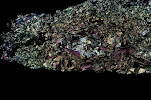I recently picked up a copy of Ender in Exile, by Orson Scott Card. Card is a writer I enjoy due to the quality of his writing, though I’m often infuriated by the philosophies espoused by some of his characters. This time the experience was, once again, mixed, with large parts of the story sucking me in and causing me to forget time was elapsing (and as a result staying up way too late at night/morning one evening), and the occasional narrow-minded pronouncement on the part of one of the characters causing me frustration that I wasn’t actually present for the conversation, and therefore am unable to explain to the speaker which points (s)he’s failing to take into consideration and why I think that their statement is in error.
However, one of the highlights for me with this book is the below quote, from
page 148 of the paperback edition (Tom Doherty Associates Publishers). To understand the quote you need to know that it is describing the observation of a place where a planet used to be, before it was completely destroyed by a “MD” field breaking apart all of its constitution atoms.
“Since the MD field broke everything into its constituent atoms, it is coalescing with remarkable quickness. Our observer ship has recently been in a position to see the dust cloud with the star directly behind it, and during the passage sufficient spectrometry and mass measurements were taken to assure us that the vast majority of the atoms have re-formed into the common, expected molecules, and that the gravity of the cloud was sufficient to hold most of the material in place. There has been some loss from escape velocity and further loss to solar gravity, solar wind, etc., but our best estimate is that the new planet will be at no less than 80 percent of the original mass, and perhaps more. At that size there will still be atmosphere, potentially breathable. There will also be molten core and mantle, ocean, and the probability of tectonic movement of thicker areas of crust-i.e. continents.
In short, while no artifacts of the former civilization can possibly be found, the planet itself will be back in a nice wad, in stellar orbit, within the next thousand years, and perhaps cool enough to explore in ten thousand years. Colonizable in a hundred thousand, if we seed it with oxygenating bacteria and other life as soon as the oceans are fully formed.”
Isn’t that a wonderful quote? Clearly the man has spent some time researching theories on the formation of planets, to have been able to write such a thing. It pleases me when part of the “Science” in a science-fiction book includes Geology!
What other fiction books have you read that do a reasonable job including geology (or in this case, I suppose, planetary science, since there aren’t any rocks, yet)?
Bandweaving Workshop in February!
3 days ago




1 comment:
Pompeii by Robert Harris has some geology in it :-) What really excited me about this is that the lead character is basically a hydrogeologist!
Post a Comment